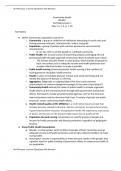Nr 442 exam 1 review Questions And Answers
Community Health
NR 442
Test Matrix Exam 1
Chp.'s 1, 2, 5, 6, 7, 26
Test Matrix
● Define Community, population, key terms
o Community: a group or collection of individuals interacting in social units and
sharing common interests, characteristics, values, and goals.
o Population: a group of people with common personal or environmental
characteristics.
▪ It can also refer to all the people in a defined community.
o Public Health: the art and science of preventing disease, prolonging life and
promoting health through organized community efforts to benefit each citizen.
▪ The mission of public health is social justice, which entitles all people to
basic necessities such as adequate income and health protection and
accepts collective burdens to make it possible.
o Public health nursing Community/public health nursing is the synthesis of
nursing practice and public health practice.
o Health: a state of complete physical, mental, and social well-being and not
merely the absence of disease or infirmity.
o Aggregates: Subgroups or subpopulations that have some common
characteristics or concerns (pregnant teenages in the same school district)
o Community Health extends the realm of public health to include organized
health efforts at the community level through both government and private
efforts. Participants include privately funded agencies such as the American
Heart Association and the American Red Cross. A variety of private and public
structures serves community health efforts.
o Health-related quality-of-life (HRQOL): is a multi-dimensional concept that
includes domains related to physical, mental, emotional, and social functioning.
It goes beyond direct measures of population health, life expectancy, and causes
of death, and focuses on the impact health status has on quality of life
o Population-focused nursing concentrates on specific groups of people and
focuses on health promotion and disease prevention, regardless of geographic
location.
● Know Public Health Assumptions
o Mission: is social justice, which entitles all people of basic necessities such as
adequate income and health protection and accepts collective burdens to make
it all possible.
o Assumption: Society’s responsibility to meet the basic needs of the people, thus
a greater need for public funding of prevention efforts to enhance the health of
our population.
Nr 442 exam 1 review Questions And Answers
, Nr 442 exam 1 review Questions And Answers
o Current U.S health policies advocate changes in personal behaviors that may
predispose individuals to chronic disease or accidents.
● Know core Public Health Functions
o Assessment
▪ regular collection, analysis, and information sharing about health
conditions, risks, and resources in a community
o Policy
▪ use of information gathered during assessment to develop local and state
health policies and to direct resources toward those policies
o Assurance
▪ focuses on the availability of necessary health services throughout the
community. It includes maintaining the ability of both public health
agencies and private providers to manage day-to-day operations and the
capacity to respond to critical situations and emergencies.
● Identify types of risk factors and modifiable risk factors
o Risk factors: variables that increase the rate of disease in people who have them
(such as genetic disposition) or in people exposed to them (an infectious agent
or a diet high in saturated fat).
▪ Types of risk factors include:
o Modifiable risk factors: aspects of a person’s health risk over which he or she has
control. Examples include smoking, leading a sedentary or active lifestyle, type
and amount of food eaten, and the type of activities in which he or she engages
(skydiving is riskier than bowling).
● Recognize examples of the 3 levels of prevention
o Primary Prevention: activities directed at preventing a problem before it occurs
by altering susceptibility or reducing exposure for susceptible individuals. It
consists of two elements
▪ General health promotion
▪ Specific population
▪ Ex. Immunization, seat belt use, water purification
o Secondary Prevention: early detection and prompt intervention during the
period of early disease pathogenesis. It is implemented after a problem has
begun, but before s/s appear, and targets those populations that have risk
factors.
▪ Ex. Mammography, blood pressure screening, scoliosis
screening,papanicolaou tests, screenings in general
o Tertiary Prevention: targets populations that have experienced disease or injury
and focuses on limitation of disability and rehabilitation. Aims of tertiary
prevention are to keep health problems from getting worse, to reduce the
effects of disease and injury, and to restore individuals to their optimal level of
functioning.
▪ Ex. Teaching how to self administer insulin, referral of patients with
spinal Cord Injury for occupational and physical therapy, leading a
support group for grieving patients.
Nr 442 exam 1 review Questions And Answers




